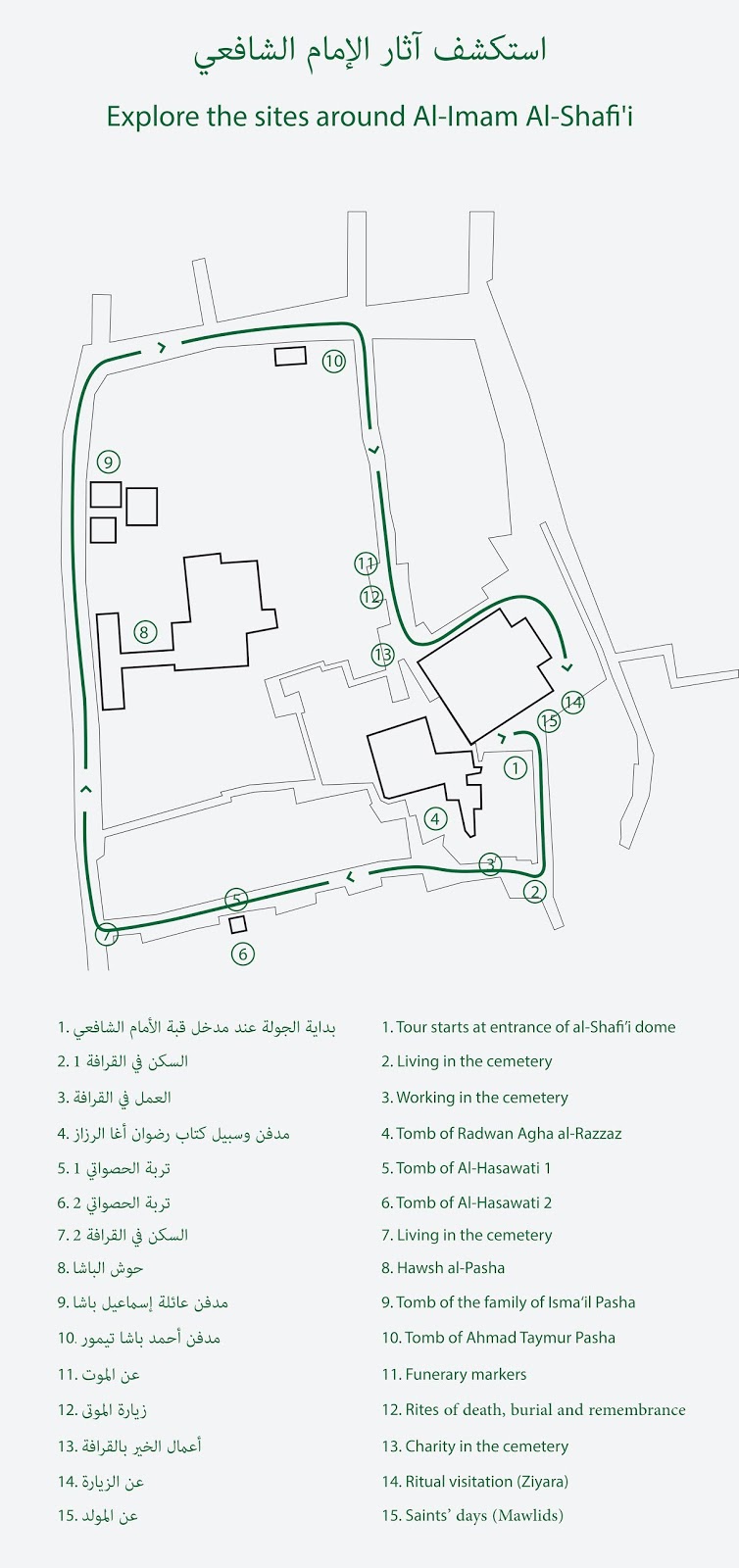عن الزيارة / Ritual Visitation (Ziyara)
واعلم أن قبور الصالحين لا تخلو من بركة وأن زائرها والمسلم على أهلها القارئ عندها والداعي لمن فيها لا ينقلب إلا بخير ولا يرجع إلا بأجر وقد يجد لذلك أمارة تبدو له أو بشارة تنكشف له
(نور الدين علي السخاوي)
كانت بعض الاضرحة والقبور تزار للتبرك. منها قبور العلماء والصالحين والمتصوفة وآل البيت. وبدءًا من العصر الفاطمي كان الزوار يستخدمون كتبًا عرفت بكنب الزيارة تصف مسارات الحركة للمرور على أهم الأماكن المبروكة والتعرف على ما يميزها. وقد ينضمون لجولات أسبوعية ينظمها شيوخ الزيارة. وتصف كتب الزيارة الآداب التي يتحتم على الزائر اتباعها فلا يصح الجلوس على القبور أو الصلاة تجاهها أو تقبيلها أو لمسها للتبرك أو إتلافها بأي حال. ومن المستحب إلقاء التحية عند الوصول والدعاء للنفس ولموتى المسلمين. كما تشير كتب الزيارة إلى كرامات لبعض الأماكن المبروكة وطقوس يجب اتباعها، قد يتناقض بعضها مع آداب الزيارة السابقة. فقد يذهب الزائر لمكان معين مشهور بإجابة الدعاء أو الشفاء من المرض أو إيفاء الدين. وقد يتحتم عليه القيام بطقوس معينة. على سبيل المثال عرف عدد من القبور -–من ضمنهم قبر عبد الوهاب البغدادي -–المصافح حيث ينصح الزوار بمصافحة بعضهم البعض للتكفير عن ذنوبهم.
استمرت الكثير من هذه العادات حتى القرن العشرين. فكان الملبوسون يزورون ضريح علي زين العابدين للتخلص من الجن ويزورون سيدي عقبة لعلاج المشاكل النفسية ورابعة العدوية للزواج. وقد يضع الزوار سبتًا من الخوص على رأسهم بضريح سيدي أو يمسحون عمود سيدي أبو العباس البصير بعصارة الليمون ويلحسونه للتخلص من الصداع. كما نسب البعض القدرة العلاجية لمياه بحيرة عين الصيرة الكبريتية لبركة الإمام الشافعي.
“Know that the graves of the righteous are never void of blessing and that s(he) who visits them and salutes their occupants and recites near them (Qur’an or religious evocations) will only have good happen and will return with reward that will unveil itself in the form of a sign or an auspicious omen”
Nur al-Din al-Sakhawi, author of a Mamluk cemetery guidebook
Certain cemetery shrines were seen as places of sanctity and blessing and sought for visitation. Certain graves and shrines were related to religious figures known for their piety, some religious scholars, some eccentric ascetics and others descendants of the prophet.
From the Fatimid period onwards, visitors could take special guidebooks or ziyara books in hand and follow itineraries and learn about the attributes of landmark sites or they could join weekly visits led by ziyara sheikhs. Ziyara books describe rules that visitors should follow. Visitors should not walk or sit on graves. They should not to damage them, kissing them, or pray towards them, nor should they touch them for blessing. Certain rituals such as greeting the dead, praying for oneself and the dead and not turning one’s back to shrines are encouraged. The guidebooks also referred to special powers and rituals in special places, some in contradiction to the rules above and some fairly benign. Visitation sites were known for granting prayers, bringing health or redeeming debt. Certain rituals in certain locations were necessary for fulfilling of these needs. For example, a number of graves, among them that of `Abd al-Wahhab al-Baghdadi, were called al-Musafih (hand shaker) because shaking hands there guaranteed redemption from one’s sins.
Many of these habits persisted well into the 20th century, the shrine of Zayn al-`Abidin was visited for exorcism from jinn, that of `Uqba was believed to cure from psychological problems and Rabi`a al-`Adawiyya was visited by women who wished to get married. Visitors placed a basket of woven reeds in the Wafa shrine over their heads to cure headaches, while in a curious ritual, people smeared the column above the grave of Abu’l-`Abbas al-Basir with lemon juice and lick it, also to cure headaches. Even the healing powers of the mineral water of `Ayn al-Sira were attributed by many to the blessing of al-Imam al-Shafi’i

